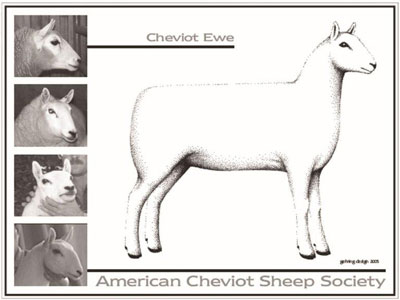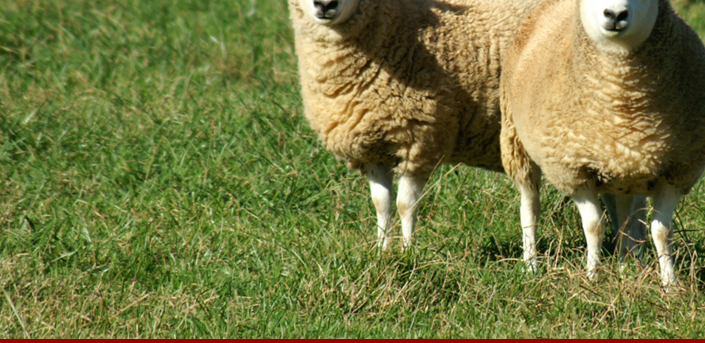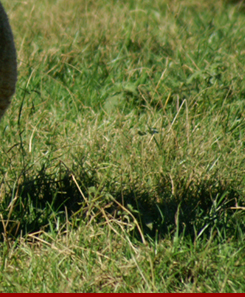|

The modern Cheviot breed has been produced by selection rather than by crossing. It is a pure breed, one of a very few in this country. Because of this purity, when the Cheviot ram is mated with crossbred ewes of other breeds, he stamps an unmistakable Cheviotness on his offspring, importing to them a large measure of the superiority of which Cheviots are known.

Distinctive Appearance
The modern American Cheviot is primarily a mutton sheep. As sheep weights go, it is definitely one of the smaller breeds but one of the most distinctive in appearance. Much of its distinctive appearance is due to the high carriage of the head and the quick, coordinated stride. The head is carried high, and the ears are carried together, erect and forward. There is no wool on the head or face in front of the ears, nor is there wool below the knees and the hocks. The head, legs, and ears are covered with very fine white hair. Their bare heads, attractive white color and absence of horns give them a very aristocratic bearing. Nostrils and hooves should be black in color. Rams in good condition mature at 160 to 200 lbs., ewes from 130 to 170 lbs.
Extreme Hardiness
The breed is also recommended for its extreme hardiness. This is one of the breed’s strongest characteristics. For generations raised on the Cheviot Hills, rarely seeing the inside of a shed or barn, summer or winter, Cheviots have, from force of circumstances, developed into the hardiest of the medium-wool breeds. The newborn lambs are strong, vigorous and alert and are born with a will to live. Their unusual vitality and hardiness makes them easy to raise, and with reasonable care, losses are insignificant.

Production Plus
Cheviot ewes are a delight for the shepherd. They bear their lambs easily, have a high number of twins, and produce plenty of milk to support them. Production records, year after year, show that their twins grow as fast as single lambs. Both the lambs and their mothers are good foragers and thrifty efficient feeders. Their grazing pattern is unlike that of other sheep. Instead of grouping together in a frontal assault on a single area, they tend to spread out over an area and get all the available feed. As rustlers, they have few equals. If there is vegetation to be found—above or beneath the snows—browse, grass, heather, or weed—they will find it.
Desirable Carcasses
The modern Cheviot has a compact body with a straight smooth back with covers a rack of well-filled, meaty chops and a broad loin of superior quality. The leg is full, round and plump. One of the outstanding merits of these choice cuts, the Cheviot has a reputation as a meat producer. These plump, meaty cuts, their pink flesh delicately trimmed with just enough fat to make them juicy and tender, are the housewife’s choice because with them she can serve her family a tasty meal with minimum waste. Because they are housewife’s choice, Cheviots are the choice of the butcher, and therefore bring a better price at the market. The Cheviot is prized by the meat packers for the very practical reason that the packer gets more pounds of lamb which he buys “on the hoof.”
Cheviot rams are excellent sires in crossbred market lamb production programs. Ewes built to deliver larger-headed lambs find the Cheviot-sired lambs, with their small heads, very easy to deliver, so that much less attention is required at lambing time. These lambs are so vigorous, strong, and hardy at birth that losses are kept at a minimum, and a higher percentage of the lambs are raised to marketing age. Successful producers of commercial lambs know their success depends upon their ability to produce the kind of lamb carcasses which the market demands, at the lowest labor and feed cost. Cheviot ram aid these commercial producers in producing the type of lambs desired by the market.
Fine Fleeces
Cheviots produce generous fleeces of white wool which is preferred by mills because its fineness, crimp, and length of staple give it superior spinning and combing qualities, and its low grease content causes less shrinkage in scouring. The fleece is usually grades 1/4 to 3/8 blood combing and is usually from four to five inches in length. Rams will normally shear 9 to 13 lbs., and the ewe will produce fleeces of 8 to 10 lbs.
All Things Considered
Though Cheviots may come in smaller packages, they contain for the sheepman a surprising combination of highly desirable qualities. They are noted for hardiness, longevity, productiveness, milking, and mothering ability and for their great activity. They are high in quality and hang a presentable carcass that has a minimum of outside fat for the amount of carcass lean produced. They utilize rough, low producing hill country very profitably with relatively little assistance from man and even less from the elements. Where there is a really tough clean-up job to be done to convert waste land into dollars, more and more sheepmen are discovering that “Cheviots can take it.”
In comparing Cheviots with other breeds, let the comparison be made on a basis of pounds of dressed lamb and clean wool produced per acre, and consider all of the costs of this production, including the year-round cost of feeding the ewe, and the time and attention required at lambing and shearing time.
Click here to view the Cheviot Breed Standards Score Cards
|

PREAMBLE
Fully recognizing the importance to all interests in the culture of Cheviot Sheep and of having a reliable record which shall be accepted as the “Final Authority” in question of pedigree and desiring to unite the experience and interest of all in guarding and perpetuating the purity of their flocks, we unite in organizing this Society.
November 1996
BYLAWS
Art. 1. Name—The name of this society shall be American Cheviot Sheep Society.
Said Society is incorporated under the laws of the State of New York as a membership organization.
Art. 2. Object—The object of this Society is: to guard and maintain the purity and encourage the breeding of Cheviot Sheep; to keep and maintain a registry for the registration of purebred Cheviot Sheep; to issue certificates of registration and transfer of same; and to do all things which may be requisite and proper in and about the carrying out the purpose and objects for which this incorporation is formed.
Art. 3. Members—a. All living Stockholders in good living standing, of the dissolved American Cheviot Sheep Society, Inc., constitute the membership in the American Cheviot Sheep Society Incorporated this 9th day of October, 1924, in the State of New York.
b. All persons interested in Cheviot Sheep who are of good moral character may become members of this Society and approved by the Board of Directors upon payment of membership fee of ten dollars.
Art. 4. The Secretary shall present the name of every applicant (with his references) for Membership to the Board of Directors and to request their ballots for or against such application—one objecting vote of the Board of Directors shall withhold such application for membership, until the next annual meeting when a two-thirds vote is required.
Art. 5. After acceptance by the Board of Directors, the Secretary will be empowered to issue a membership certificate duly signed by the President and Secretary.
This membership is non-transferable, is entitled to one vote and ceases with the death of the holder.
Art. 6. Officers—The officers of the Society (who shall also serve as the officers of the Board) shall be President, a First Vice-President, and a Second Vice-President to be elected from the Board of Directors by the members of the Board at their Annual Meeting. The Secretary and treasurer shall be appointed by the Board of Directors. Five Directors shall constitute a quorum. At the death, resignation or disability of the President, his duties will be assumed successively by the First Vice-President and the Second Vice-President; at the death or resignation or disability of any other officer or director, his or her place shall be filled by the officers of the Board until the next Annual Meeting of the Board.
There shall be thirteen Directors. The term of each Director shall be three years, and the terms of four Directors shall expire at the Annual Meeting each year after this year in which this amendment is passed, except every third year when the terms of five Directors shall expire. The term of the President and the Vice-Presidents shall be one year.
The Board of Directors shall divide the United States into four districts. Not less than two directors shall be elected from each district plus five at large.
The Eastern district shall contain the states lying east of Ohio, Kentucky, Tennessee and Alabama.
The East Central district shall contain the states lying between the Eastern district and the Mississippi River.
The Western district shall contain the states west of Montana, Wyoming, Colorado, and New Mexico.
The West Central district shall contain the states lying between the Western district and the Mississippi River.
Art. 7. Duties of Officers—The duties of the officers and the Board of Directors shall be such as usually pertain to such offices in the usual transaction of business.
The President will appoint a three member financial review panel annually to review the Association’s business transactions prior to the Annual Meeting.
The Panel will consist of two directors and one at-large association member. The panel will report to the President the findings of the said review.
The President will convey the findings to the Association members at the Annual Meeting.
Art. 8. The Secretary and tTreasurer shall give a bond at the discretion of the Board of Directors continued for the faithful performance of his duties.
He shall receive such compensation for his services as the Board of Directors deems just.
Art. 9. Meetings—An Annual Meeting of this Society shall be held at a date and place agreed upon by the Board of Directors. The membership shall be given a thirty day notice of the time and place selected. At this meeting, at which time the directors of the Society shall be elected by a majority of the members present. No voting by proxy.
Five members to constitute a quorum.
Art. 10. Amendments—These Bylaws may be amended by a majority vote of the members voting at any regular meeting. Notice of the proposed amendments having been previously give to each member. No voting by proxy.
Seal—The Seal of this Society shall be a circle with the words American Cheviot Sheep Society with an inserted cut of a Cheviot Sheep’s head.
Art. 11. A member charged with willful misrepresentation in regard to any animal owned or bred by him, or with any dishonorable conduct, if such charge be fully sustained, the Board of Directors may suspend him until the next Annual Meeting when a full hearing of the evidence, such as offending member may be expelled by a two-thirds vote of the members voting.
Art. 12. A registry of Purebred Cheviot Sheep shall be established and kept by the Secretary subject to such rules and regulations as may from time to time be adopted by the Society.
RULES OF ENTRY
Rule 1. Sheep imported from England or Scotland, whose breeding will permit their registration in the British Flock Book, shall be entitled to registration upon satisfactory evidence being furnished by the Secretary of their purity. The following statement must be filed with the Secretary concerning imported sheep, 1. Name of animal to be recorded. 2. Date of birth. 3. Sex. 4. Number and initial on the ear label or tattoo. 5. Date of importation. 6. Name of vessel or port of entry. 7. Names of breeder, importer, and owner with the address of each; blanks must be signed by the importer.
Usually satisfactory evidence is given in the form of a letter from the British Secretary vouching for the flock from which the importation is made.
The American Cheviot Sheep Society has a working agreement with the Canadian National Livestock Records that Canadian sheep, registered or eligible to registry (coming into the United States from Canada) will be accepted for our records and re-registered in the American Cheviot Sheep Society at regular registration rates.
Rule 2. The progeny of sheep as indicated above shall be entitled to registration.
Rule 3. The Direct descendants of sheep registered in the American Cheviot Sheep Society shall be entitled to registration.
Rule 4. If subsequently proven that any animal has been admitted improperly, the facts of the case shall be recorded; the animal disbarred and no progeny tracing to such animal shall be thereafter admitted.
Rule 5. All sheep for which application is made for registry must be labeled with an ear tag or tattoo bearing the breeder’s applicant’s name or initials thereon and no numbers shall be duplicated. Should any sheep be labeled with another breeder’s label it shall not be changed. If a label is lost it must be promptly replaced with a duplicate of the original.
Rule 6. Blank application forms and breeding certificates will be furnished by the Society, but not private ear labels.
Rule 7. The fee for registration shall be $4.00 for each animal under one year of age, or $5.00 for each animal over one year of age and under two years of age. Any animal over two years of age will reflect present fee scale. The fees to be paid by non-members shall be doubled these amounts. For the purposes for this rule, an animal shall be considered to become one year old on the first day of February of the year following the year in which it was born.
Rule 8. Animals when approved will have “Record” numbers assigned them and certificates of registry will be forwarded to the owner.
Rule 9. Transfers are to be made out in full and paid for by the seller. Transfer fees shall be $4.00 per head, said transfers to be filed with the Secretary within three months from the date of delivery, where such transfers are neglected beyond three months, fees shall be doubled and when neglected beyond one year they must be referred to the executive committee which shall have the power to order transfer to be made upon satisfactory proof that the animals have been paid for by the transferee.
Rule 10. In case a ewe is bred to a ram not owned by the owner of the ewe, a certificate, signed by the owner of the ram, must accompany application for registry. Blanks will be furnished by the Society.
Rule 11. Transfers must be filled in and signed with pen by owner or agent making sale.
Transfer of ownership shall not be considered recorded unless it shows the signature of the Secretary or this Society.
Pedigrees extended to four generations and details will be furnished at $6.00 each to members.
No information pertaining to pedigrees or transfers of any sheep will be given to any person or agency other than to a member of the A.C.S.S. who owns or has owned one or more sheep involved in such pedigrees or transfers except when required to do so by a court order of the executive committee.
Rule 12. Certified 4-H and FFA members are accorded the privilege of membership rates in transactions with the Society office and are not required to pay the Annual Service Fee.
Rule 13. An annual service fee of $10.00 shall be charged all members and non-members doing business with the National Office effective January 1, 2002. |
Click here to view the Bylaws of the American Cheviot Sheep Society
|



![]()
![]()



